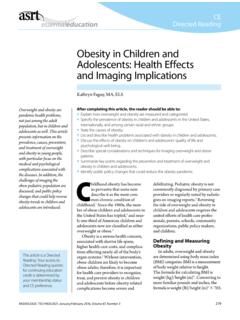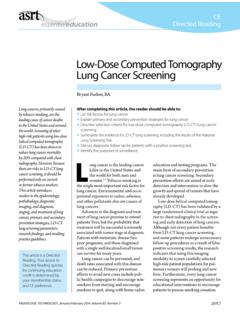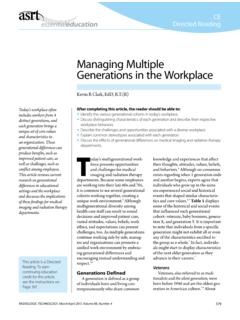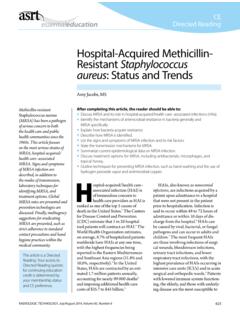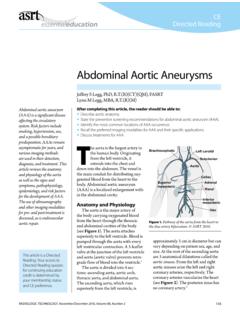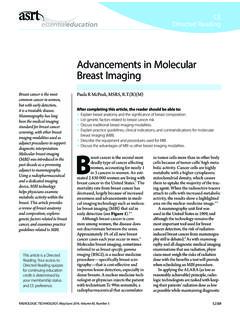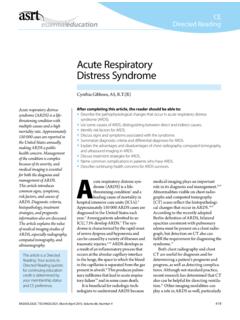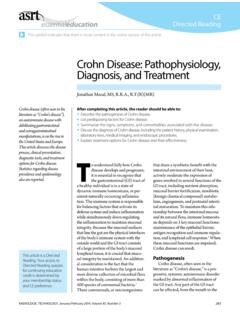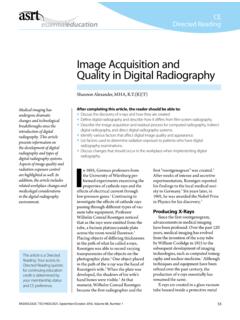Transcription of Imaging Foreign Bodies - American Society of Radiologic ...
1 655 Radiologic TECHNOLOGY, July/August 2014, Volume 85, Number 6 CEDirected ReadingThis article is a Directed Reading. Your access to Directed Reading quizzes for continuing education credit is determined by your membership status and CE preference. Kathryn Faguy, M A, ELSF oreign Bodies are frequently encountered in medical Imaging and can range from intentionally placed objects, such as medical devices and surgical hardware, to debris from accidents and injuries and a wide variety of swallowed items. Many for-eign Bodies are well visualized with radiography, ultrasonography, or another Imaging modality1 and, once detected, are often easily treated or even resolve spontaneously. Occasionally, however, Foreign Bodies go undetected and can have serious consequences. Untreated Foreign Bodies can cause a variety of complications, including obstruction and perforation, nerve injury, chronic pain, abscesses, draining sinuses, and life-threatening Delayed diagnosis can result in cellulitis and deep-tissue infections such as myo-necrosis and necrotizing In addition to being painful and a potential source of infection, Foreign Bodies also cause many lawsuits4.
2 An estimated 4% of liability claims against emergency department physicians involved Foreign Bodies in soft tissue,3 and Foreign Bodies were reported to be the second leading cause of lawsuits against emergency department , for example, the case report of a boy, aged 8 years, who fell from a tree and suffered a puncture wound on the back of his right During initial treatment in an emergency depart-ment, no Imaging examinations were performed. The wound was closed and amoxicillin was prescribed. Two days later, the boy presented to a different health care facility with pain and redness in his thigh and a high fever. At surgery, a 2 4-cm piece of wood was removed from the midthigh area, along with necrotic tissue and 10 cc of pus. Cultures from the wound grew a variety of bacte-ria, including Escherichia, Streptococcus, and Enterococcus treatment with intravenous antibiotics and hyperbaric oxygen, the infection persisted and the boy s con-dition worsened.
3 A follow-up culture After completing this article, the reader should be able to: List some challenges associated with detecting Foreign Bodies . Compare and contrast the capabilities of radiography, ultrasonography, computed tomography, and magnetic resonance Imaging to visualize Foreign Bodies . Summarize research findings on the best methods for Imaging glass, metal, wood, plastic, stone, and rubber Foreign Bodies . Describe the Imaging appearance of a variety of special types of Foreign Bodies . Discuss how Imaging is used intraoperatively to aid the removal of Foreign technologists are likely to image a wide variety of Foreign Bodies in the course of their careers and should know which techniques work best in different circumstances. This article reviews the strengths and limitations of radiography, ultrasonography, computed tomography, and magnetic resonance Imaging for visualizing Foreign Bodies and describes the Imaging appearance of some common Foreign -body materials, including glass, metal, wood, plastic, stone, and rubber.
4 Several special types of Foreign Bodies also are discussed, such as medical devices, concealed packets of illegal drugs, and self-embedded items. The intraoperative role of Imaging during removal of Foreign Bodies also is Foreign BodiesCEDirected Reading656 Radiologic TECHNOLOGY, July/August 2014, Volume 85, Number 6 Imaging Foreign Bodiesgrew Clostridium perfringens. One week after the injury, a second surgery revealed necrosis of the adductor and pos-terior thigh muscles. Hip disarticulation (ie, amputation) was performed. Subsequently, the boy had a systemic inf lammatory response with reduced cardiac function, pleural effusion, and hemiparesis. A magnetic resonance (MR) scan of his head showed cortical laminar necrosis on both sides of his brain. He improved gradually during several weeks of hospitalization and underwent rehabili-tation for 3 months.
5 Nevertheless, his coordination, fine motor skills, and vision were permanently , it is critical to detect Foreign Bodies at the ear-liest opportunity. Prompt diagnosis simplifies treatment, avoids complications, and improves However, diagnosing Foreign Bodies can be difficult for many rea-sons. This is especially true for deeply embedded objects and those that are not apparent on In addi-tion, the onset of symptoms related to a retained Foreign body can sometimes be delayed for months or even years so that the patient might not connect current symptoms with a prior injury (see Box 1).2 A lso, many people delay treatment for Foreign -body injuries. In one study, three-quarters of patients with a Foreign body in soft tissue sought medical care within 48 hours; the other one-quarter did not seek care until sometime Pediatric patients present a special diagnostic challenge when they cannot accurately relate what happened or describe their symptoms, such as an infant or toddler who has swal-lowed or aspirated a Foreign body.
6 Some patients might not be aware of an injury involving a Foreign body if, for instance, they have compromised sensation as in diabetic Finally, Imaging modalities have widely dif-fering capabilities to visualize different types of Foreign Bodies , and no single modality is ideal in all and Comparison of Modalities Used to Image Foreign BodiesMany Foreign Bodies 78% according to one report are discovered using only physical examination and sur-gical exploration, without Imaging However, depending on the Foreign body s size and location, blind surgical exploration can be a slow and frustrating process, with no guarantee of Furthermore, surgery can be high risk, especially when the surgical site contains many nerves and blood vessels, such as the hands and feet, where Foreign Bodies often are located.
7 In many cases, Imaging Foreign Bodies before attempting removal can save physicians time and avoid additional injury and anxiety for However, a Foreign body that is vis-ible using one modality might be easily overlooked using a different The Foreign body s size, location, and composition should all be taken into consideration when choosing an Imaging and FluoroscopyRadiography frequently is used to detect Foreign Bodies and traditionally has been the first-choice Box 1 Case Study: Migrating Fish Bone6A woman, aged 69 years, presented to a hospital in Japan with swelling and redness in the front of her neck that had worsened in the past few days. Computed tomography (CT) scans showed a fine linear radiopaque object on the right side of her neck (see Figure 1). The patient recalled that she had a fish bone stuck in her throat 9 months earlier, although she had not had any symptoms until very recently.
8 Blood tests indicated mildly elevated levels of white blood cells and C-reactive protein, and the patient was prescribed antibiotic medications. Her symptoms improved after a few days, but contrast-enhanced CT and 3-D CT still showed the linear Foreign body situated inside the thyroid gland and extending outside the gland. Ultrasonography also clearly revealed a linear Foreign body (see Figure 2).6 Surgery was performed, and a mass of scar tissue was discovered in and extending beyond the thyroid with a fish bone embedded in it. The bone, which measured 34 mm, was removed, and the patient recovered without complications (see Figure 3).6 The authors noted that accidentally swallowed fish bones are common in East Asia because fish are often served whole with the bones intact. (After bones of various sorts, dentures are the next most commonly swallowed Foreign body in adults.)
9 7 Although it is not clearly understood how swallowed bones migrate to other parts of the body, one theory is that esophageal peristalsis and neck motion both might contribute to the phenomenon. Because exploratory surgery of the neck can be like searching for the proverbial needle in a haystack, the authors stressed the importance of preoperative Imaging , especially Reading 657 Radiologic TECHNOLOGY, July/August 2014, Volume 85, Number 6 Faguymodality because it is inexpensive and available at most health care facilities. However, radiography s ability to detect Foreign Bodies depends on the object s size, location, orientation, and Radiography can detect most radiopaque Foreign Bodies (ie, objects that are relatively impermeable to x-rays and therefore appear white on radiographs). Ta ble 1 displays the radi-opacity of some Foreign body materials in Hounsfield units, a measurement used in computed tomography (C T) s c a n n i n g.
10 Two commonly encountered types of radiopaque for-eign Bodies are glass and metal. Radiography s sensitiv-ity for detecting glass Foreign Bodies ranges from Ta b l e 1 Radiopacity of Some Foreign -Body Materials, Measured in Hounsfield Units (HU)10 Material HUMetal3863-5363 Graphite 750 -1036 Glass 540-1740 Acrylic 8 0 -13 0 Wood 50-80 Figure 1. A. Axial computed tomography (CT) scan showing a fish bone (arrow) near the thyroid gland. B. 3-D CT scan showing the fish bone oriented obliquely downward (arrow). Reprinted from Watanabe K, Amano M, Nakanome A, Saito D, Hashimoto S, The prolonged presence of a fish bone in the neck, 227, 49-52, (2012), with permission from Tohoku University Medical 2. Ultrasonographic image of the fish bone in the long axis. Reprinted from Watanabe K, Amano M, Nakanome A, Saito D, Hashimoto S, The prolonged presence of a fish bone in the neck, 227, 49-52, (2012), with permission from Tohoku University Medical 3.
